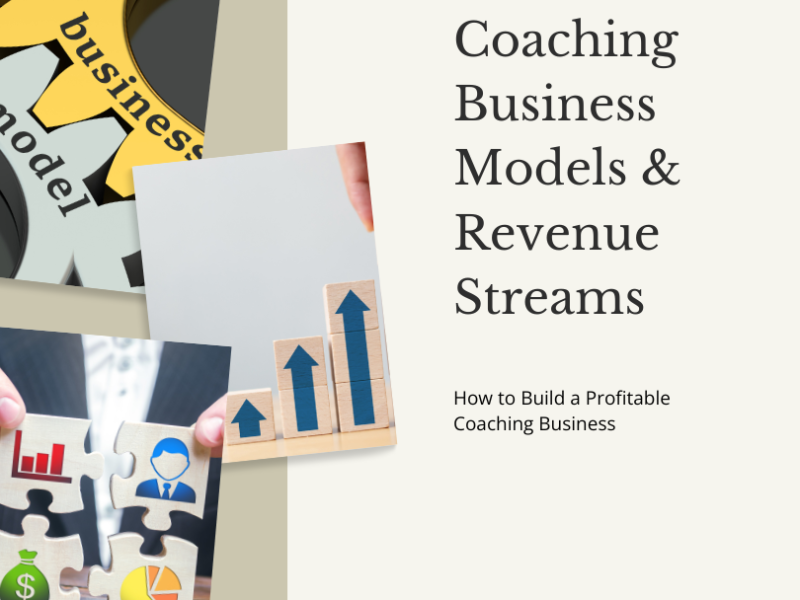
The coaching industry is growing rapidly, with professionals worldwide turning their expertise into highly profitable businesses. However, success in coaching isn’t just about being a great mentor—it’s about having the right business model and revenue streams to scale your impact and income.
In this article, we’ll break down the most effective coaching business models, explore diverse revenue streams, and help you choose the best approach to build a sustainable and scalable coaching business.
Why Choosing the Right Coaching Business Model Matters
Your business model determines how you attract clients, deliver coaching services, and generate revenue. Without a clear strategy, many coaches struggle with inconsistent income, burnout, or difficulty scaling.
A well-structured coaching business should:
✅ Offer multiple revenue streams to stabilize income
✅ Allow scalability so you don’t trade time for money
✅ Provide value and transformation to clients at different levels
✅ Align with your expertise, lifestyle, and financial goals
Let’s dive into the top coaching business models and how you can implement them.
Top Coaching Business Models for Coaches
1️⃣ One-on-One Coaching (High-Ticket Coaching)
🔹 Best for: Premium clients who need personalized guidance
🔹 Revenue Potential: $$$ High (but limited by time)
One-on-one coaching is one of the most common business models, offering personalized coaching sessions to clients via Zoom, phone, or in-person meetings.
💡 Pros:
✅ High-ticket pricing potential ($500 – $10,000 per client)
✅ Deep impact with personalized attention
✅ Builds strong relationships & credibility
⚠️ Cons:
❌ Not scalable—you trade time for money
❌ Can lead to burnout if not structured properly
💡 How to optimize:
🔹 Offer VIP coaching packages for premium clients
🔹 Set clear boundaries and pricing to avoid overworking
🔹 Use automated scheduling tools to manage clients efficiently
2️⃣ Group Coaching Programs
🔹 Best for: Coaches who want to scale while maintaining direct engagement
🔹 Revenue Potential: $$$ High (with lower time commitment)
Group coaching involves coaching multiple clients at once in a structured format, usually through weekly sessions, mastermind groups, or boot camps.
💡 Pros:
✅ More scalable than 1:1 coaching
✅ Creates a community-driven coaching experience
✅ More affordable for clients while keeping revenue high
⚠️ Cons:
❌ Requires strong facilitation skills to manage group dynamics
❌ Clients may not receive personalized attention
💡 How to optimize:
🔹 Offer tiered pricing (Basic, VIP, Elite)
🔹 Use tools like Zoom, Kajabi, or Teachable for delivery
🔹 Pre-record lessons and use live Q&A for engagement
3️⃣ Online Courses & Digital Products
🔹 Best for: Coaches who want passive income
🔹 Revenue Potential: $$$$ Very High (unlimited scaling)
Creating online courses, e-books, templates, or digital guides allows coaches to package their expertise into products that generate revenue 24/7.
💡 Pros:
✅ Passive income stream
✅ Unlimited scalability—no time limitations
✅ Positions you as an authority in your niche
⚠️ Cons:
❌ Requires upfront effort in content creation
❌ Needs strong marketing to attract buyers
💡 How to optimize:
🔹 Use platforms like Teachable, Udemy, Kajabi
🔹 Bundle courses into signature coaching programs
🔹 Implement email funnels and ads for automated sales
4️⃣ Membership & Subscription Models
🔹 Best for: Coaches who want recurring income
🔹 Revenue Potential: $$ Medium (steady and predictable)
A membership program provides exclusive ongoing coaching, training, or community support for a monthly or annual fee.
💡 Pros:
✅ Recurring revenue = more stability
✅ Creates a loyal customer base
✅ Can be low-cost and high-value for clients
⚠️ Cons:
❌ Requires consistent content updates
❌ Needs a strong community engagement strategy
💡 How to optimize:
🔹 Offer different membership tiers (Basic, Pro, VIP)
🔹 Provide live coaching calls, templates, and exclusive content
🔹 Use Discord, Facebook Groups, or Circle for engagement
5️⃣ Corporate Coaching & B2B Consulting
🔹 Best for: Coaches who want high-paying corporate contracts
🔹 Revenue Potential: $$$$ Very High (but requires networking)
Many businesses invest in leadership development, team coaching, and performance training, offering a lucrative coaching opportunity.
💡 Pros:
✅ High revenue potential—corporates pay premium fees
✅ Consistent long-term contracts
✅ Positions you as a thought leader
⚠️ Cons:
❌ Longer sales cycles (need strong networking)
❌ Requires customized solutions for different companies
💡 How to optimize:
🔹 Develop corporate coaching packages
🔹 Partner with HR departments & business networks
🔹 Use LinkedIn marketing & workshops to attract clients
Diversify Your Coaching Revenue Streams
A successful coaching business doesn’t rely on just one income stream. The best strategy is to combine multiple revenue sources for sustainable growth.
🔹 Ideal revenue stream balance:
✅ 40-60% Marketing & Client Acquisition
✅ 20-30% One-on-One or Group Coaching
✅ 20-40% Passive Income (Courses, Memberships, Books)
Final Thoughts: Choose the Best Coaching Model for YOU
The best coaching business model depends on your goals, expertise, and lifestyle preferences.
🔥 Want high-ticket clients? → One-on-One or Corporate Coaching
🔥 Want scalability? → Group Coaching or Online Courses
🔥 Want recurring revenue? → Membership or Subscription Models
🔥 Want passive income? → Digital Products & Automated Funnels
By choosing the right mix of business models and revenue streams, you can maximize your income, impact, and freedom as a coach.
💬 Which coaching business model are you currently using? Let’s discuss in the comments! 🚀

Comments